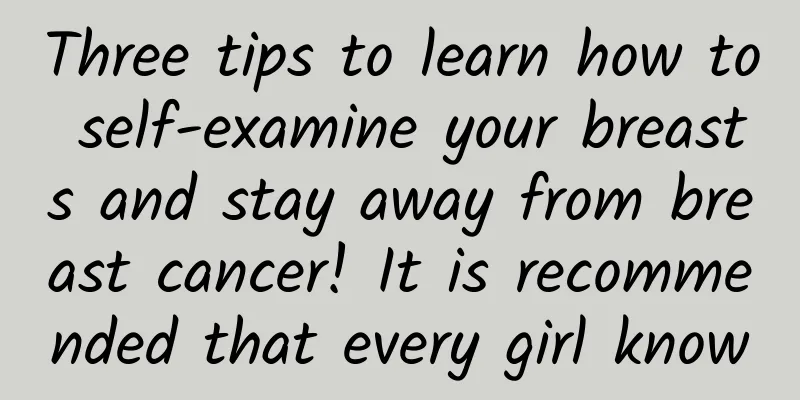Three tips to learn how to self-examine your breasts and stay away from breast cancer! It is recommended that every girl know

|
The World Health Organization has designated October of each year as "World Breast Cancer Awareness Month", also known as "Pink Ribbon Month", with the aim of raising awareness of breast disease prevention among more women. Recently, Grandma Wang, who is over 60 years old, felt a lump in her right breast while taking a bath, so she went to the Hunan Provincial Hospital of Integrated Traditional Chinese and Western Medicine (Affiliated Hospital of Hunan Institute of Traditional Chinese Medicine) for treatment. After careful examination by Director Tang Wei of the Oncology Department 4 and Deputy Director Wang Huazhong , combined with clinically relevant auxiliary examination methods, she was finally diagnosed with "breast cancer." Thanks to timely discovery and the meticulous treatment and care of the medical team of Department of Oncology IV, the patient’s condition has been effectively controlled. “Early diagnosis, fast treatment, and good efficacy!” The patient’s quality of life has been improved. When she was discharged from the hospital, Grandma Wang gave a thumbs up to the medical staff and expressed her sincere gratitude! 1. What is breast cancer?Breast cancer is one of the most common malignant tumors in women. With the improvement of living standards, the incidence rate has gradually increased, becoming the number one killer threatening women's health. Early detection of breast problems and learning to self-check breast abnormalities are of great significance for the prevention and treatment of precancerous lesions and malignant tumors. Although breast self-examination cannot replace professional medical examinations, as an accessible means of self-monitoring, it can help many women detect breast abnormalities early and seek medical treatment and treatment in a timely manner. 2. How can women check themselves at home?1. Take a look Stand or sit in front of a mirror, and carefully observe both sides of your breasts facing the mirror, including any changes in size, shape, contour, skin and color, and whether the nipples are elevated, sunken, or have abnormal discharge. 2. Two touches Raise one arm and place it behind your head, and use the fingertips of the other arm to gently touch your breast. Start from the nipple and gradually move outwards in a circular clockwise or counterclockwise direction. Pay attention to check if there are any abnormal sensations such as lumps, nodules, pain, etc. At the same time, do not miss the areola and the area around the breast, including the armpit and pectoralis major. 3. Three squeezes Note that after the touch examination, gently squeeze the nipple and areola area with your thumb and index finger to observe whether there is any abnormal secretion: Under normal circumstances, the fluid secreted by the nipple should be clear or a small amount of white; if bloody fluid or fluid of other colors is found, you should go to the hospital for examination in time. 3. Notes on self-examination1. When self-examining, be careful not to press the breasts too hard. Use your fingertips to press the breasts lightly and avoid pinching them hard to avoid mistaking normal breast tissue for a lump. 2. Self-examination should be performed about one week after menstruation, because the breast tissue is looser at this time, making it easier to detect abnormalities. 3. Check yourself regularly and record the results. After each self-examination, record the condition of your breasts, including any slight changes or discomfort, for future comparison. If there are any abnormal changes or concerns, seek medical attention immediately. 4. If there is a family history of breast cancer or other related diseases, more attention should be paid to self-examination and regular check-ups. Self-examination of breast conditions is simple and easy, and women should be vigilant and understand it. Regular self-examination can help women detect possible abnormalities in the breast (such as nodules, fibroids, inflammation, etc.) early. Tang Wei, director of the Oncology Department IV of Hunan Provincial Hospital of Integrated Traditional Chinese and Western Medicine (affiliated hospital of Hunan Provincial Institute of Traditional Chinese Medicine), reminds: Early detection, early exclusion, early treatment, early recovery, and paying attention to breast cancer-related precancerous lesions are also very important! Regular examination, improvement and control of symptoms can greatly reduce the chance of canceration, thereby reducing the incidence of advanced breast cancer. In real life, people are very afraid of cancer. In addition to women, a small number of elderly, obese men with a family history of breast cancer also need to pay attention to their breast health to prevent the occurrence of male breast cancer. But in fact, there is no need to panic too much. Many breast cancer patients can also achieve the goal of long survival and good quality of life. Women’s health is the foundation of family harmony and happiness. Let us work together to protect breast health and safeguard a better life!
(Edited by ZS) |
>>: Beware! The "fourth high" after the "three highs" is quietly coming. Have you been infected?
Recommend
How long does the egg survive in the body after ovulation?
Healthy women ovulate every month, and strong and...
What is the difference between early and late fetal movement
For women who have never been pregnant, they will...
Belly enlargement after miscarriage
It is a measure taken by couples after they get p...
SNAP: Global user DAU reached 218.1 million in 4Q19, and revenue reached US$561 million
Snap, which claims to be the Facebook of young pe...
What are the reactions during menopause?
When women reach middle age, they will enter meno...
Can I do eyebrow tattoos while breastfeeding?
Love of beauty is a woman’s nature. If you cannot...
What are the 20 golden rules for mothers to educate their children? How to educate children who are disobedient?
Tao Xingzhi: Education is "life education&qu...
Can I take a bath during my menstrual period?
Can I take a bath during my period in the dog day...
How to quickly supplement estrogen
Estrogen is a female hormone produced by the plac...
Can I drink chrysanthemum and wolfberry tea at night? What are the effects of drinking mint chrysanthemum tea when staying up late?
Modern people are becoming more and more aware of...
What is the success rate of medical abortion in 38 days?
During sex, if contraception is not timely, the p...
Female lower back pain with leg pain
If a woman has lower back pain and leg pain on on...
Chitosan Gynecology
Gynecological inflammation is a common problem fo...
What should I do if I drink beer during my period?
Women's menstruation is also called menstruat...
Understand obstetrics and gynecology care: key considerations before and after pregnancy!
Obstetrics and gynecology care refers to the proc...









